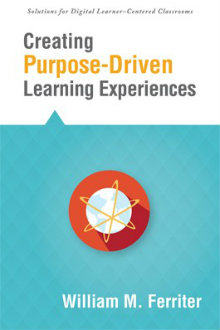Creating Purpose-Driven Learning Experiences
Creating Purpose-Driven Learning Experiences
By William M. Ferriter
(Solution Tree Press, 2015 – Learn more)

“Helping students to succeed at meaningful work, then, depends on our ability to build a bridge between what today’s kids can do and what they are doing with technology.” ~ William M. Ferriter, Creating Purpose-Driven Learning Experiences (page 5)
Looking for ideas for engaging students in meaningful work in your classroom? Interested in expanding on your students’ technology use to involve them in “doing work that matters”?

Bill Ferriter’s book is easy to read with a combination of research and practical ideas for incorporating meaningful project-based learning work into 21st century classrooms.
Meaningful Work for 21st Century Students
Ferriter shares a clear and well-written summary of research to support the idea that today’s schools need “innovative teachers … working to find ways to give students opportunities to demonstrate intellectual agency” (page 8).
He gives examples of project-based learning in action at three schools that clearly illustrate high levels of student engagement when students are doing “work that matters” while also showing that project-based learning has a positive impact on academic growth as well.
Micro-lending and Blogging – Project-Based Learning Ideas
Ferriter writes from his own classroom-based experience engaging his students in micro-lending projects – raising money to make small loans for people living in poverty to help them achieve economic independence. What a great way for students to make real-world contributions and work collaboratively on projects they research and choose.
I appreciated that Ferriter also poses questions that can help other teachers to determine whether microlending projects will meet the needs of their specific classrooms. The hand-outs provided, available in the book and online, are useful tools to help those new to project-based learning to implement a micro-lending project and allow teachers to personalize the resources as desired.
Ferriter also shares personal experiences using blogging in connection with his micro-lending projects, and offers tips and resources for teachers.
Making School Different
For those interested in project-based learning, but not sure that micro-lending is the right fit, the final chapter of the book is full of additional ideas for using project-based learning to involve students in “meaningful work.”
In addition to the real-world examples and supportive materials provided in earlier chapters, Ferriter includes summaries of recommended resources and the URLs for further investigation.
I have long felt that we should be doing things differently in education, but I shared Ferriter’s thinking that “the strain of balancing what I know matters the most for my students with the need to produce results on simplistic (yet essential) end-of-grade exams has left me professionally broken” (page 57).
This book helped me to see a path toward doing new and different things with my students that would engage them, using technology, to do work that matters beyond the classroom doors.
Dena Hause has been a classroom teacher for over 30 years, working at both the elementary and middle school levels. Currently she works for the San Diego Unified School District as an Educational Technology Resource teacher. In this capacity she supports students and teachers throughout the district as they work to integrate technology into their curriculum for a blended learning experience. She recently earned a Master’s degree in Educational Leadership with a Focus on Technology from San Diego State University.






























